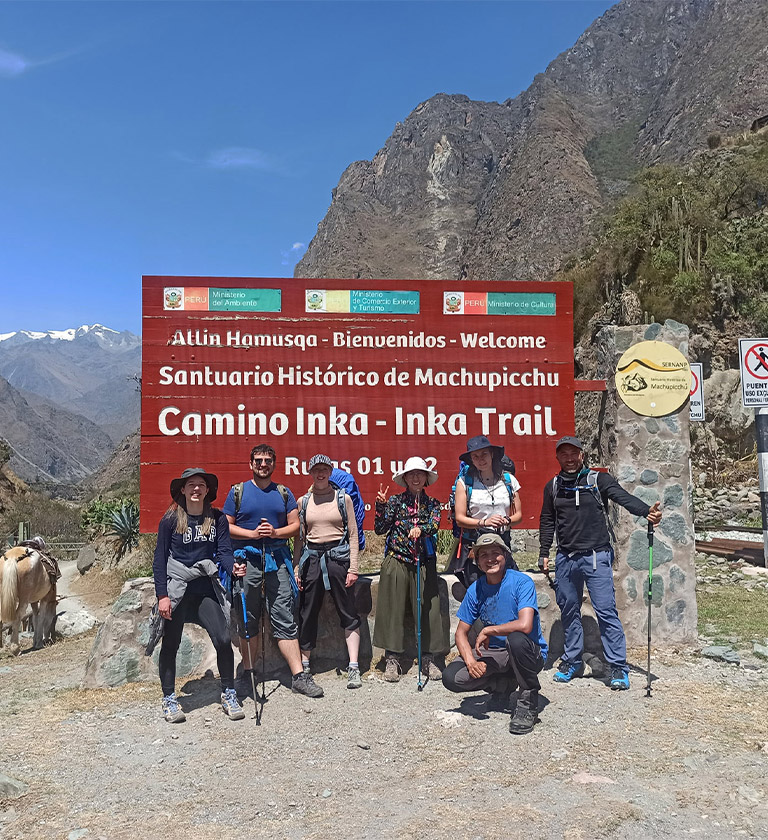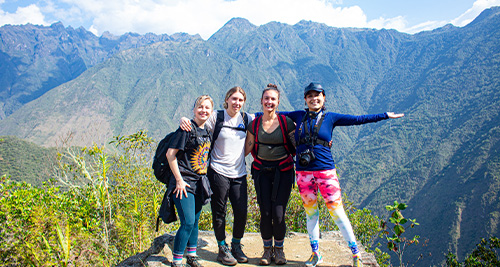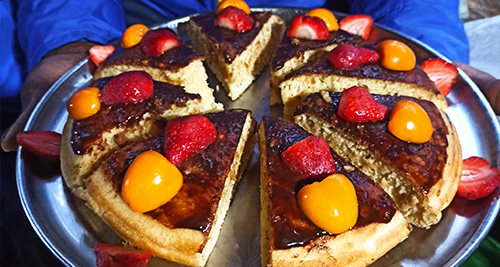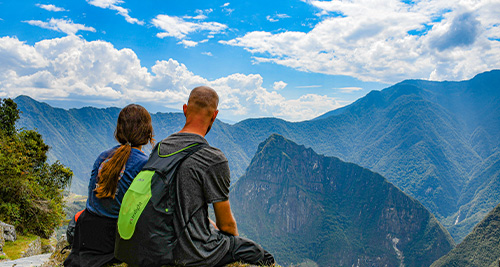
Most Famous Trek in Peru!
 4 days / 3 nights
4 days / 3 nights  From US$ 750,00 per person
From US$ 750,00 per person  Difficulty:
High
Difficulty:
High  Max. Altitude:
4,220 m
Max. Altitude:
4,220 m  43 km
43 km 
Machu Picchu has different trekking access, but the Classic Inca Trail is the most famous.

The chef will cook for you during your hike up to Machu Picchu, taste tasty local savors.

All trek is full of incredible panoramic views. Enjoy from the highland to the cloud forest in Machu Picchu.
Day
Cusco - Ollantaytambo (short stop) - Wayllabamba
Day
Wayllabamba - Warmiwañusca Pass - Pacaymayo
Day
Pacaymayo - Sayacmarca - Puyupatamarca - Wiñayhuayna.
Day
Wiñay Huayna - Inti Punku(Sun Gate) - Machu Picchu – Cusco

Begin the day by collecting you from your hotel for the 1½ hour drive to Ollantaytambo, where you will stop for 20 minutes in a restaurant. You can use toilets, buy water, snacks, chocolates and get the last things you may have forgotten to buy in Cusco city.
To reach the trailhead, you will drive one more hour after Ollantaytambo to km 82. Before starting your trek, the team will organize your backpacks and ensure you have all you need for the first-day hike.
After crossing the Urubamba River, you will walk 3 hours through farmland along the Urubamba river until your first stop and lunch near the first archeological site called Llactapata. After a delicious meal prepared by our chef, you will continue for another 3 hours to reach our campsite in Wayllabamba. Finally, you will have dinner and relax in preparation for the next day.
DURING THE TREK:
Early morning you have a wake-up call, 5:00 a.m. or 5:30 a.m., depending on your tour guide. Warm wash water and a high-energy breakfast will be waiting for you. Also, you will have some time to refill your water bottle and be given some snacks for the day to help you get over the mountain pass.
Wayllabamba campsite to Warmiwañusca (Dead Woman Pass) is an uphill climb of approx. 7 km. It is considered the most challenging part of the path. However, the changes in the vegetation and landscape as you climb through different climatic zones will keep you involved with the hike and focused on discovering more as you climb.
At the top of the mountain pass, you will be greeted with panoramic views of distant mountains. Looking back into the valley you have just climbed out of, congratulate yourself for your accomplishment. Looking ahead, you will see your way on toward Machu Picchu.
After the pass, we have approximately 3 km going downhill to reach Pacaymayo campsite. Our team will be waiting for you there with food, warm wash water, and your tent already set up. For the rest of the afternoon, you will be able to rest and enjoy before happy hour and dinner at the end of the day.
DURING THE TREK:
Begin this new day with breakfast. Then, after a short climb, you will reach a remarkable Inca lookout called Runcurakay. Your tour guide will describe the importance of this place. Then after 1½ hours more to go the second pass, you’ll be able to enjoy the view from the second-highest spot on the trail. There are 1½ hours of stairs down to a dramatic Inca site, Sayacmarca, perched high on the ridge. Take pictures and learn of the historical background from your guide.
Lunch will be near your following archeological site Puyupatamarca, a spectacular tumble of buildings where you will have a view of all the mountains around Machu Picchu far below. Then you will start a descent, going into the rainforest with a beautiful cover of vegetation with orchids, bromeliads, ferns, and many other native plants. Also, if you are lucky, you can see and hear some of the hundreds of birds in the area.
Three hours downhill to Wiñayhuayna will be the last challenge before you finish the day and enjoy tea time. Finally, a delicious dinner, take a nap, and prepare for the next best day: Machu Picchu.
DURING THE TREK:
Last day, you wake up early and commence the hike to Machu Picchu (2 hours). You know you arrive when you pass through the Sun Gate (Inti Punku). If the weather conditions are reasonable, you will have unforgettable panoramic views of Machu Picchu from this spot. After just one more hour downhill, you will enter the iconic Inca Citadel. Your tour guide will take you inside Machu Picchu with his knowledge, telling you all about this majestic city for around 2 hours. After this tour, you will have free time to take pictures, feel energies and discover more of Machu Picchu. Also, if you registered to hike up Huayna Picchu or Machu Picchu Mountain, this is the time you will do that.
Once you complete the visit to the Citadel, it will be time to go down to Aguas Calientes. You can take the bus for 25 minutes or walk for one more hour. In Aguas Calientes, you can enjoy your last lunch with the group. Then decide to relax in the hot springs (for ten soles) or explore the shops and craft stalls in the Village.
Later in the afternoon, you will catch the train to Ollantaytambo (1 hour 50 minutes). In Ollantaytambo, you need to get out of the train station and transfer to a bus where the driver will be waiting to take you from Ollantaytambo to Cusco (1½ hours.)
DURING THE TREK:
Not Included
Shared service price: $.750.00.
Important: Shared service price is only available with agreement passengers to share this service with other travelers (Group site 06 – 12 People approx.)
Private service price: $.950.00. (based on two people)
Included all mentioned before
Group size upon your request, for people who need a personalize and exclusive service
Departure day is according to passenger request
Price for bigger groups are according to group size
Do you need to book a Private tour? Book here.
What you should bring
Important to know!
What is the Inca Trail 4-Day trek?
The Inca Trail 4-day trek is a famous hiking trail in Peru that leads to the ancient Incan citadel of Machu Picchu. The trail itself is approximately 26 miles (42 km) long and takes 4 days to complete, starting from the Sacred Valley of the Incas (Piscacucho) and ending at Machu Picchu.
The trek is popular among tourists because it not only provides a challenging hike through the beautiful Andes mountains but also allows hikers to experience the rich history and culture of the Inca civilization. Along the way, hikers pass through numerous archaeological sites, including Runkurakay, Sayacmarca, and Phuyupatamarca, before reaching the famous Sun Gate (Inti Punku), which offers a breathtaking view of Machu Picchu.
The Inca Trail 4-day trek is a popular option, but there are also shorter and longer versions of the trail available, including a 2-day trek and a 5-day trek that includes a visit to the Incan ruins of Choquequirao. However, due to its popularity, the Inca Trail requires a permit, and only a limited number of permits are available per day, so it’s essential to plan and book the trek in advance.
What is the best time of year to do the Inca Trail 4-Day trek?
The best time of year to do the Inca Trail 4-Day trek is during the dry season, which typically runs from May to September. During this period, the weather is generally sunny and dry, making for more comfortable hiking conditions. The trail is also less likely to be closed due to weather conditions, which can be a problem during the rainy season.
However, the dry season is also the busiest time on the trail, so it’s important to book your trek well in advance to secure your spot. If you prefer a quieter experience and don’t mind the possibility of some rain, you might consider trekking during the shoulder seasons of April or October.
It’s worth noting that the Inca Trail is closed for maintenance every February, so you won’t be able to trek during this month. Additionally, the Inca Trail permits are limited to 500 per day, including guides and porters, so it’s important to book early to avoid disappointment.
How physically challenging is the Inca Trail 4-Day trek?
The Inca Trail 4-Day trek is considered a moderately to highly physically challenging trek, as it involves hiking for several hours each day at high altitudes with steep inclines and declines.
The trek covers approximately 43 kilometers (26 miles) and reaches altitudes of up to 4,215 meters (13,828 feet) at the highest point. The terrain is rugged and uneven, and hikers must navigate stairs, rocky paths, and narrow passages.
The altitude can also be a significant factor, as many people experience altitude sickness symptoms such as headaches, nausea, and shortness of breath. It’s essential to acclimatize properly before starting the trek and to drink plenty of water and rest when needed.
Overall, the Inca Trail 4-Day trek requires a good level of fitness, as hikers can expect to walk for six to eight hours per day with limited opportunities to rest. However, with adequate preparation and a positive attitude, it’s an achievable and rewarding experience.
How high is the altitude on the Inca Trail 4-Day trek?
The Inca Trail 4-Day trek reaches altitudes of up to 4,215 meters (13,828 feet) at the highest point, which is Warmiwañusca, also known as Dead Woman’s Pass. This point is reached on the second day of the trek and is the highest point on the trail.
The trail begins at an altitude of 2,800 meters (9,186 feet) at the starting point of Kilometer 82, and the altitude gradually increases as you make your way towards Dead Woman’s Pass. Hikers can also expect to encounter other high-altitude passes along the way, including Runkurakay Pass (3,950 meters or 12,959 feet) and Phuyupatamarca Pass (3,680 meters or 12,073 feet).
It’s important to acclimatize properly before starting the trek and to drink plenty of water and rest when needed to prevent altitude sickness symptoms. If you’re concerned about the altitude, you might consider spending a few days in Cusco or other high-altitude destinations in Peru before starting the trek to help your body adjust to the altitude.
What kind of accommodation is provided during the Inca Trail 4-Day trek?
There are camping accommodations ,sleeping bags, and mattress, as there are no hotels or lodges along the trail.
What kind of food is provided during the Inca Trail 4-Day trek?
The meals typically include a variety of fresh fruits and vegetables, carbohydrates such as rice and pasta, and protein sources such as chicken, beef, or vegetarian options like beans or quinoa. Breakfast might consist of porridge, bread, eggs, and fruit, while lunch and dinner might include soups, stews, and other hearty dishes. Snacks such as fruit, nuts, and energy bars are also provided.
The meals are prepared by a team of cooks and porters who accompany the trekking group, and the food is cooked using portable gas stoves and basic cooking equipment. The cooks are experienced at preparing meals in challenging conditions and can cater to dietary requirements such as vegetarian, vegan, gluten-free, or lactose-free.
It’s important to note that the availability of fresh ingredients and equipment can be limited on the trail, so the meals may not be as varied or elaborate as what you would expect in a restaurant. However, most trekkers find the food to be tasty, filling, and a highlight of the trekking experience.
How far in advance should I book the Inca Trail 4-Day trek?
It’s recommended that you book the Inca Trail 4-Day trek at least 6-8 months in advance, especially if you plan to trek during the peak season of May to September. This is because the number of people allowed on the trail is limited to 500 per day, including porters and guides, and the permits often sell out several months in advance.
In addition to booking your trek early, it’s also important to ensure that you have all the necessary documents and permits, including your passport and Inca Trail permit. We will be able to assist you with obtaining these documents, but it’s important to plan ahead and allow sufficient time for any necessary paperwork or arrangements.
What gear should I bring on the Inca Trail 4-Day trek?
When packing for the Inca Trail 4-Day trek, it’s important to keep in mind that you will need to carry your own gear, so it’s important to pack as light as possible. Here are some essential items that you should bring:
A comfortable backpack with a capacity of at least 40 liters to carry your personal items and water.
Sturdy and comfortable hiking boots with good ankle support.
Moisture-wicking and quick-drying clothing suitable for hiking, including long-sleeved shirts, pants, and a waterproof jacket.
Warm layers such as a fleece jacket or down jacket for cold nights.
A sun hat, sunglasses, and sunscreen to protect yourself from the sun.
A headlamp or flashlight with extra batteries for use in the evenings and early mornings.
A refillable water bottle or hydration system to stay hydrated on the trail.
Insect repellent to protect yourself from mosquitoes and other bugs.
A first aid kit containing essentials such as band-aids, painkillers, and any prescription medications you need.
Personal toiletries, including toilet paper and wet wipes.
Cash for purchasing snacks or tipping your guides and porters.
Can I hire a porter for the Inca Trail 4-Day trek?
es, you can hire a porter for the Inca Trail 4-Day trek. In fact, many trekkers choose to hire porters to carry their gear and make the trek more comfortable and enjoyable.
Is it necessary to have a guide for the Inca Trail 4-Day trek?
Yes, it is necessary to have a guide for the Inca Trail 4-Day trek. The Peruvian government requires that all trekkers on the Inca Trail be accompanied by a licensed guide. This is to ensure the safety of trekkers and to protect the environment and cultural sites along the trail.
What are the highlights of the Inca Trail 4-Day trek?
The Inca Trail 4-Day trek is a truly unforgettable experience, with stunning scenery, fascinating historical sites, and a challenging but rewarding hike. Here are some of the highlights of the trek:
Machu Picchu: Of course, the most famous highlight of the Inca Trail 4-Day trek is the chance to visit the ancient Incan city of Machu Picchu. This breathtaking site is a UNESCO World Heritage Site and is considered one of the New Seven Wonders of the World.
Beautiful Scenery: The Inca Trail is renowned for its stunning scenery, including snow-capped mountains, lush forests, and sweeping vistas. Along the way, you’ll see numerous Incan ruins and structures, including the impressive Wiñay Wayna terraces.
Cultural Experience: The Inca Trail is an incredible opportunity to learn about the history and culture of the Incan people. Your guide will share fascinating stories about the ancient civilization and their impressive engineering feats.
Physical Challenge: The Inca Trail 4-Day trek is a challenging hike, with steep inclines, high altitudes, and long days on the trail. But the sense of accomplishment when you reach Machu Picchu is well worth the effort.
Wildlife: The Inca Trail is home to a variety of wildlife, including llamas, alpacas, vicuñas, and a range of bird species. Keep an eye out for these fascinating creatures as you hike.
Overall, the Inca Trail 4-Day trek is a once-in-a-lifetime experience that combines physical challenge, cultural immersion, and incredible natural beauty.
Can I climb Huayna Picchu on the Inca Trail 4-Day trek?
Yes, it is possible to climb Huayna Picchu during the Inca Trail 4-Day trek, but it requires an additional permit and must be booked in advance. Huayna Picchu is the towering peak that overlooks Machu Picchu and offers stunning panoramic views of the surrounding mountains and valleys.
The Peruvian government limits the number of visitors allowed to climb Huayna Picchu to 400 per day, split into two groups of 200 climbers each. This means that permits for Huayna Picchu can sell out quickly, especially during peak tourist season.
How many people are in a group on the Inca Trail 4-Day trek?
Groups are max 12 people with the shared group service however can be smaller with the private service
What kind of toilets are available on the Inca Trail 4-Day trek?
On the Inca Trail 4-Day trek, toilet facilities are limited and basic. Along the trail, you will find squat toilets at the various campsites and rest stops. These are usually very basic and do not have running water, so it is a good idea to bring hand sanitizer or wet wipes to clean your hands after using them.
Are there any medical facilities on the Inca Trail 4-Day trek?
There are no medical facilities or hospitals on the Inca Trail itself, but most tour operators will have a basic first aid kit and a trained guide who can provide basic medical assistance in case of minor injuries or illnesses.
If you have a pre-existing medical condition or require specific medication, it’s important to bring all necessary medication and supplies with you on the trek. It’s also a good idea to inform us of any medical conditions or concerns prior to the trek, so we can provide appropriate support and accommodations.
Can I drink the water on the Inca Trail 4-Day trek?
It is not recommended to drink the water directly from streams or rivers on the Inca Trail 4-Day trek, as it may contain harmful bacteria or parasites that can cause illness. It is important to always treat your water before drinking it.
What happens if I can’t complete the Inca Trail 4-Day trek?
If you are unable to complete the Inca Trail 4-Day trek due to illness, injury, or other reasons, your tour operator will have a plan in place to assist you.
Depending on the circumstances, you may be able to continue the trek, or you may need to return to Cusco or nearby towns for medical attention or rest.
Customer can continue using the entrance to Machu Picchu the sam they it supposes to arrived (extra expenses like trainn bus or any other, customer need to pay them).
Do I need a visa to visit Peru for the Inca Trail 4-Day trek?
It depends on your nationality. Peru has visa exemption agreements with many countries, allowing visitors to stay for a certain period without a visa.
You can check if you need a visa by visiting the website of the Peruvian embassy or consulate in your country, or by consulting with a travel agent or visa specialist.
What happens to my luggage during the Inca Trail 4-Day trek?
Luggage that will not be used at Inca trail can be dropped at the hotel you can back after your trek or also can leave at our office.
Can I charge my electronics on the Inca Trail 4-Day trek?
If you need to charge your electronic devices during the trek, it’s recommended that you bring a portable power bank or solar charger to ensure that you have enough power to last throughout the trek. These can be charged during the day while you are hiking and can provide a reliable source of power for your devices.
What are some tips for preparing for the Inca Trail 4-Day trek?
Preparing for the Inca Trail 4-Day trek requires physical and mental preparation as well as proper gear and clothing. Here are some tips to help you prepare:
Start training early: The Inca Trail trek can be physically challenging, so it’s important to start training well in advance. This can include cardiovascular exercise, strength training, and hiking or walking on uneven terrain.
Acclimate to altitude: The Inca Trail reaches high elevations, so it’s important to acclimate to altitude before starting the trek. This can include spending a few days in Cusco or other high-altitude locations before the trek.
Pack properly: Bring appropriate clothing and gear for the trek, including comfortable hiking shoes, layers for changing weather conditions, and a daypack for carrying essentials.
Stay hydrated: Proper hydration is essential for high-altitude trekking, so be sure to drink plenty of water and bring a refillable water bottle or hydration system.
Eat well: Fueling your body with nutritious food is important for the physical demands of the trek, so make sure to eat a balanced diet with plenty of carbohydrates, protein, and healthy fats.
Take it slow: The Inca Trail is a challenging trek, so it’s important to take your time and go at your own pace. This can help prevent altitude sickness and injury.
Be mentally prepared: Trekking the Inca Trail can be a mentally challenging experience as well, so be prepared to stay positive and motivated throughout the trek.
By following these tips and preparing properly, you can have a safe and enjoyable experience trekking the Inca Trail.
Need more recommendations? read our blog

Search